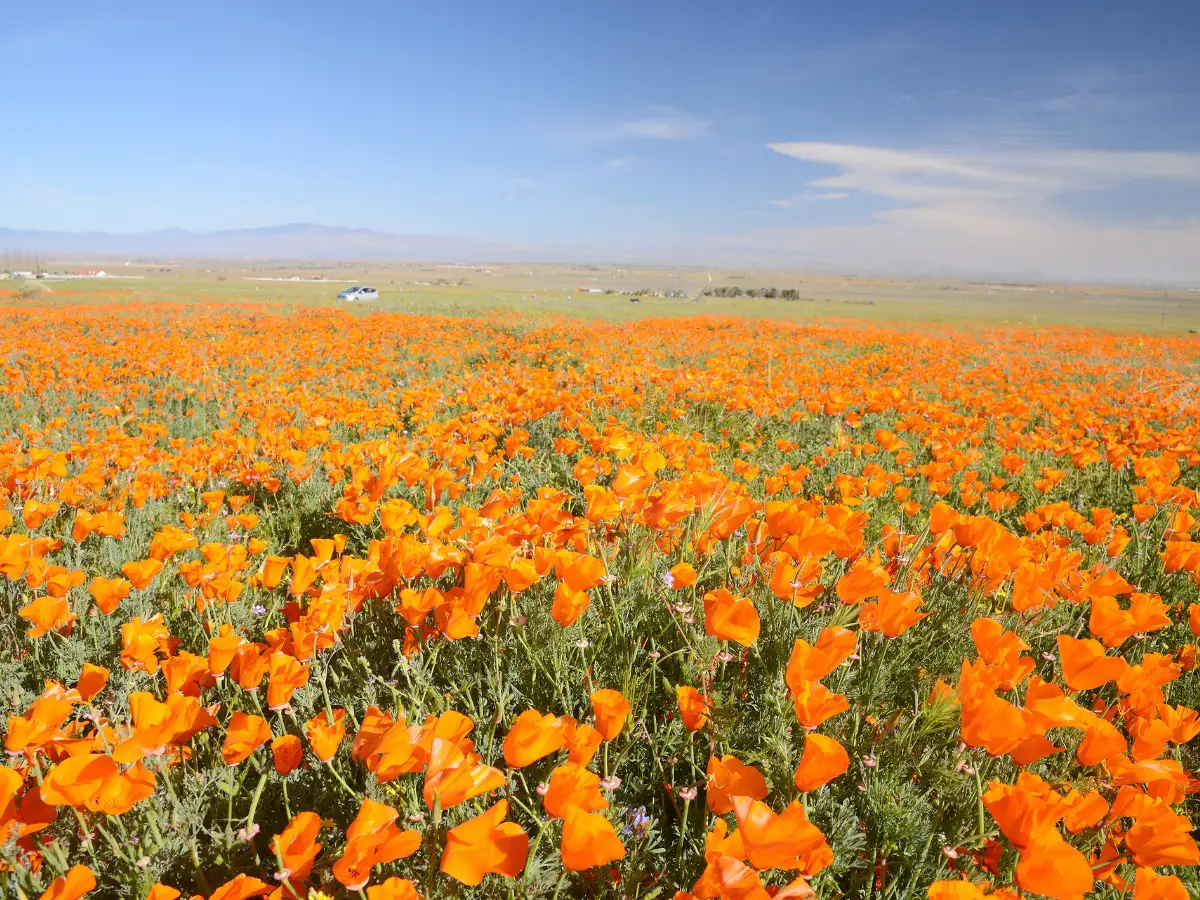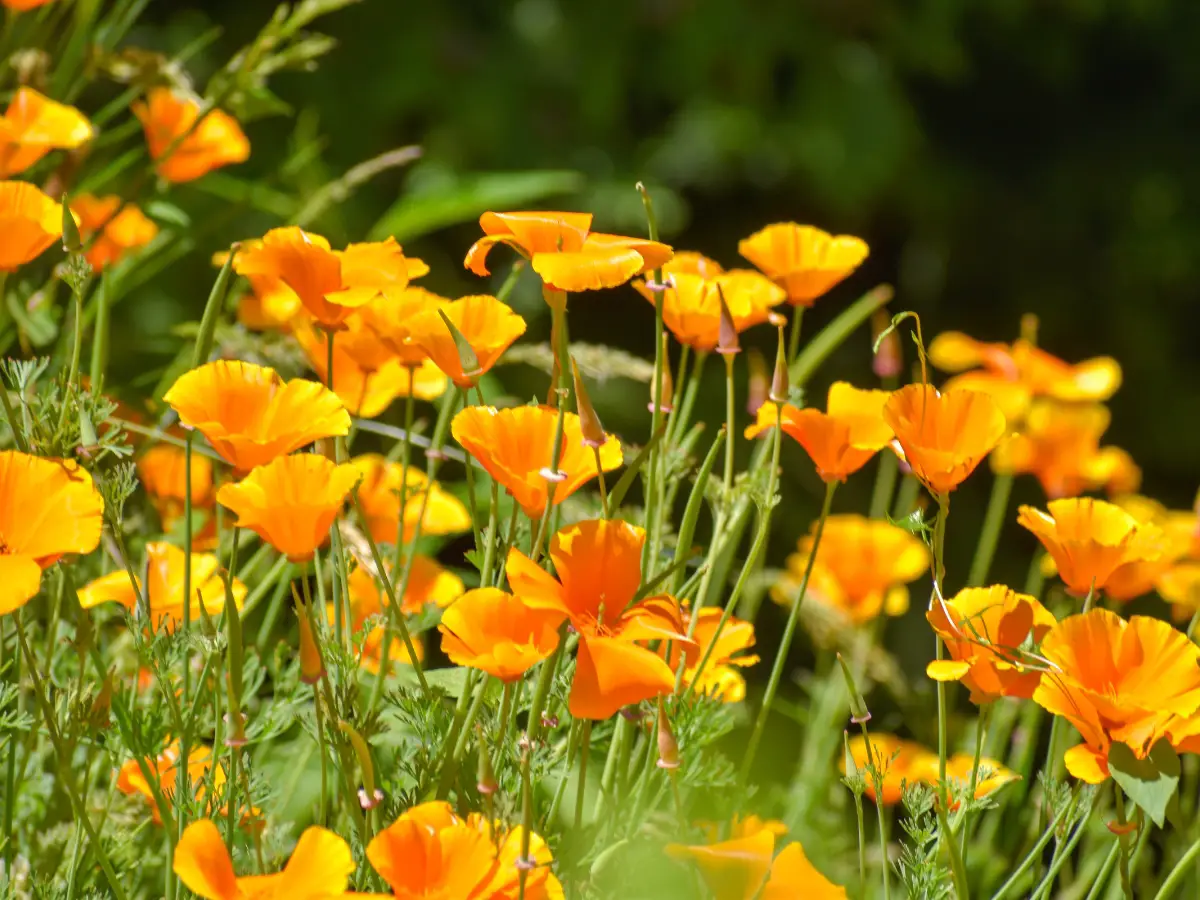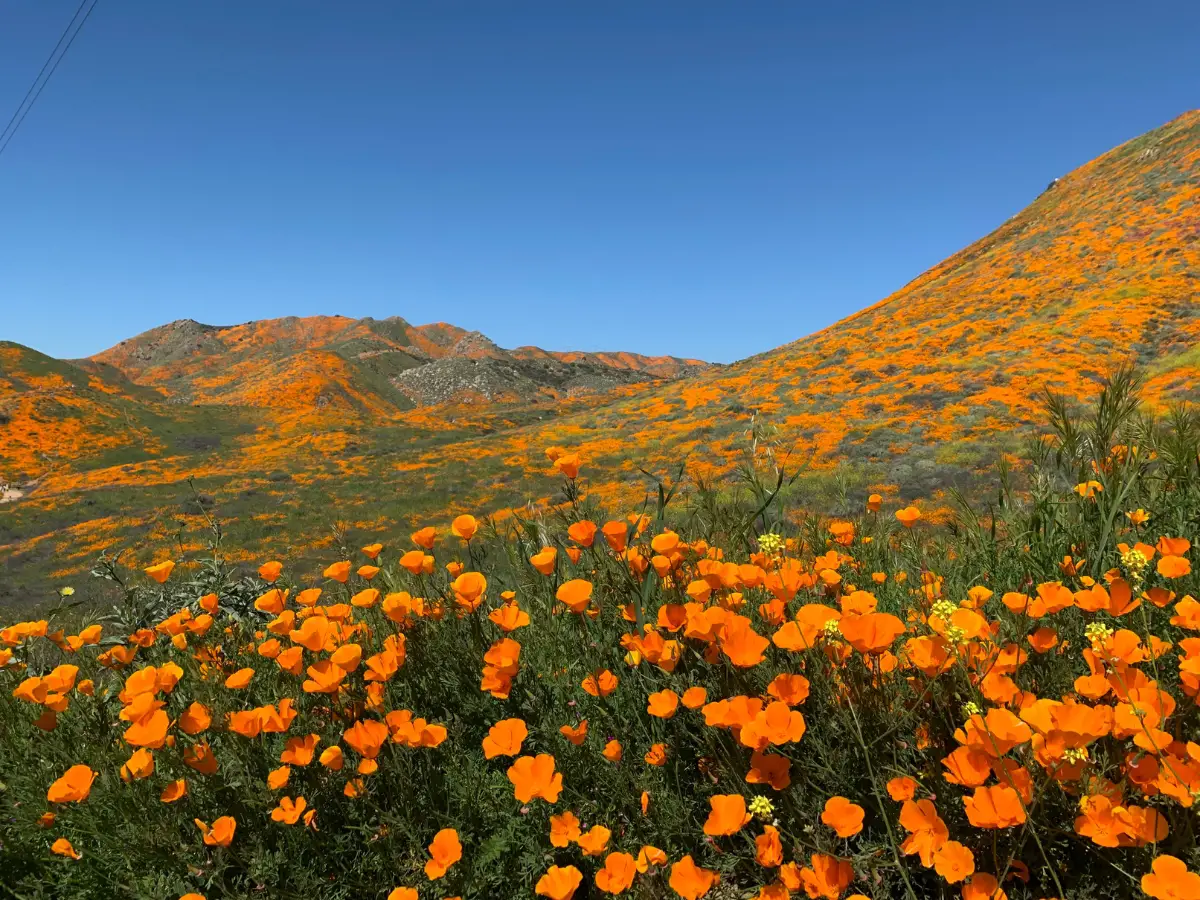California poppies are popular for gardeners due to their bright colors and easy-to-grow nature. However, many people wonder if these flowers are perennials or annuals. The answer is that California poppies can be both, depending on the conditions in which they are grown.
In their native habitat, California poppies are considered perennials and can return year after year. However, in other areas, they are often grown annually and replanted yearly. Understanding the lifespan of California poppies is essential for gardeners who want to incorporate these beautiful flowers into their landscape.
By learning more about these plants, gardeners can make informed decisions about how to care for them and ensure their longevity.

Understanding California Poppies
California poppies, scientifically known as Eschscholzia californica, are one of the most popular wildflowers in North America. They are famous for their bright golden-orange blooms, which have earned them the title of California’s state flower. But are they perennials or annuals?
The answer is that California poppies can be both. In their native habitat, California poppies are short-lived perennials, meaning they can live for two or more years. However, in most home garden settings, they are treated as annuals, meaning they only last for one growing season.
One of the reasons why California poppies are so popular is that they are incredibly easy to grow. They thrive in full sun and well-drained soil, making them perfect for rock gardens, borders, and containers. They are also drought-tolerant, making them an excellent choice for gardeners who live in hot and dry climates.
California poppies are available in a wide variety of colors, including red, pink, and white. They are also available in different shapes and sizes, with some varieties growing up to three feet tall. They are usually propagated by seed, which can be sown directly into the ground in the spring or fall.
In conclusion, California poppies are a beautiful and easy-to-grow species that can be either annuals or perennials depending on the growing conditions. They are perfect for adding a splash of color to any garden and are sure to attract bees, butterflies, and other pollinators.

Life Cycle of California Poppies
California poppies are beautiful wildflowers that are native to California. They are known for their vibrant orange color and delicate petals. These flowers are often grown as annuals, but they can also be grown as perennials in some regions. Here’s what you need to know about the life cycle of California poppies.
Annual or Perennial?
California poppies can be grown as annuals or perennials depending on the climate and growing conditions. In colder regions, they are usually grown as annuals because they cannot survive the winter. In warmer regions, they can be grown as perennials because they can survive the winter and come back year after year.
Dormancy
California poppies have a dormant period during the summer months. The seeds are shed and lie dormant over the hot summer, waiting to germinate with the first rains of autumn. This dormancy period is important for the survival of the plant because it allows the seeds to wait until the conditions are right for growth.
Growth
California poppies grow quickly once they start to germinate. They prefer full sun and sandy, well-drained soil. They can grow up to 12 inches tall and 6 inches wide. The plants have a bushy growth habit and produce multiple stems with flowers at the top of each stem.
Flowering
California poppies flower in the spring and summer months. The flowers are typically orange, but they can also be red, pink, or white. The flowers are cup-shaped with delicate petals that close at night and open during the day. The flowers attract bees and other pollinators, making them an important part of the ecosystem.
In conclusion, California poppies can be grown as annuals or perennials depending on the climate and growing conditions. They have a dormant period during the summer months, grow quickly once they start to germinate, and flower in the spring and summer months. These beautiful wildflowers are a great addition to any garden or landscape.

California Poppies’ Colors
California poppies are known for their vibrant and eye-catching colors. They come in a variety of shades and hues, ranging from the common to the uncommon. Here, we’ll take a closer look at the different colors of California poppies.
Common Colors
The most common colors of California poppies are:
- Orange: This is the most recognizable color of California poppies. It’s bright, bold, and cheerful, and is the color most people associate with these flowers.
- Yellow: Yellow California poppies are also relatively common. They’re a bit softer and more subdued than the orange variety, but still very pretty.
- White: White California poppies are less common than the orange and yellow varieties, but they’re still relatively easy to find. They’re a bit more delicate and understated than the other colors, but can be quite beautiful in their own right.
- Pink: Pink California poppies are also relatively common. They’re a bit more unusual than the other colors, but can be quite striking.
Uncommon Colors
While the colors listed above are the most common, California poppies can also come in a variety of other shades and hues. Some of the less common colors include:
- Red: While not as common as orange, red California poppies can be quite stunning. They’re a bit more rare than the other colors, but can be a real showstopper in the garden.
- Bright Orange: Bright orange California poppies are a bit more intense than the standard orange variety. They’re a great choice if you want to add a pop of color to your garden.
- Double: Double California poppies are a bit more unusual than the single varieties. They have extra petals, which makes them look a bit fuller and more lush than the standard varieties.
- Colors: California poppies can come in a range of different colors, from deep purples to soft blues. While these colors are less common than the ones listed above, they can add a unique and unexpected touch to your garden.
Overall, California poppies are a great choice if you’re looking for a colorful and eye-catching addition to your garden. With so many different colors to choose from, you’re sure to find a variety that suits your style and taste.

Cultivation and Care
California poppies (Eschscholzia californica) are a popular choice for gardeners due to their bright and cheerful blooms, and they are a great addition to any garden. These plants are native to California and thrive in warm, dry climates. Here are some tips for cultivating and caring for your California poppies.
Ideal Climate
California poppies prefer a warm and dry climate with full sun exposure. They can tolerate some shade, but they will not bloom as well. These plants are hardy in USDA hardiness zones 6-10.
Soil Requirements
California poppies prefer well-drained soil with a pH between 6.0 and 7.5. They can tolerate poor soil, but they will not grow as well. If you are planting in containers, make sure they have good drainage.
Watering and Fertilizing
California poppies are drought-tolerant and only need occasional watering. Overwatering can cause the plants to rot. They do not require fertilizer, but you can add a light application of a balanced fertilizer in the spring if you want to encourage more blooms.
Seeding and Germination
California poppies are easy to grow from seed. They can be sown directly in the garden in the fall or early spring. Make sure the soil is well-draining and keep the soil moist until the seeds germinate. Once the plants are established, they will self-seed and come back year after year.
Disease and Pest Control
California poppies are generally disease and pest resistant. However, they can be susceptible to powdery mildew and other fungal diseases in humid conditions. To prevent these diseases, make sure the plants have good air circulation and avoid overhead watering. If you notice any signs of disease, remove the affected leaves and treat the plants with a fungicide if necessary. Common pests that can affect California poppies include aphids, slugs, and snails. Use insecticidal soap or other organic pest control methods to keep them under control.
In summary, California poppies are a beautiful and low-maintenance addition to any garden. By providing them with the right growing conditions and proper care, you can enjoy their vibrant blooms year after year.
Propagation of California Poppies
California poppies can be propagated through seeds. The seeds should be sown in rows about 6 inches apart in well-drained soil. The best time to sow the seeds is in the fall, but they can also be sown in the spring.
To sow the seeds, prepare the soil by loosening it to a depth of about 12 inches. Then, scatter the seeds on the soil surface and cover them with a thin layer of soil. Water the soil gently and keep it moist until germination occurs.
California poppies are known to self-seed, so if you let the flowers go to seed, they may come back on their own the following year. However, if you want to control where they grow, it’s best to remove the spent flowers before they go to seed.
Once the seedlings have emerged, thin them to about 6 inches apart. If you want to transplant the seedlings, wait until they have a few true leaves and then carefully lift them from the soil with a small trowel. Transplant them into their new location and water well.
Overall, California poppies are easy to propagate from seed and can be a beautiful addition to any garden.
Special Characteristics
California poppies are known for their unique characteristics that make them a popular choice for gardeners and nature enthusiasts alike. Here are some of the special features of this beautiful plant:
Native and Wild: California poppies are native to the United States and are found in the wild across the Pacific slope of North America from Western Oregon to Baja California. They are also known as the state flower of California.
Hardy and Easy to Grow: California poppies are hardy plants that can grow in a variety of soil types and conditions. They are easy to grow from seed and require minimal care, making them a popular choice for novice gardeners.
Drought-Tolerant: California poppies are well-adapted to dry and arid environments, making them an ideal choice for water-wise gardening. They can tolerate periods of drought and do not require frequent watering.
Papaveraceae Family: California poppies belong to the Papaveraceae family, which includes other well-known plants such as the opium poppy and the Oriental poppy.
Food for Bees: California poppies produce nectar and pollen, which makes them an important food source for bees and other pollinators. They are also known to attract butterflies and other beneficial insects to the garden.
In summary, California poppies are a beautiful and versatile plant that can add color and interest to any garden. They are hardy, easy to grow, and drought-tolerant, making them an ideal choice for water-wise gardening. They are also an important food source for bees and other pollinators, making them a valuable addition to any garden ecosystem.
California Poppies in Floral Arrangements
California poppies are a popular choice for floral arrangements due to their bright and vibrant colors. These flowers are known for their delicate and airy appearance, which makes them perfect for creating a whimsical and romantic atmosphere. Here are a few things to keep in mind when using California poppies in floral arrangements:
Cut flowers: California poppies are delicate flowers that do not last very long once they are cut. To ensure that your poppies last as long as possible, cut them early in the morning when the flowers are still fresh and the stems are full of water. Make sure to change the water in the vase every day to keep the flowers hydrated.
Container: When using California poppies in a container, make sure to choose a container that is large enough to accommodate the plants. These flowers have a tendency to spread out, so you will need to give them plenty of space to grow. Choose a container that has good drainage to prevent the roots from becoming waterlogged.
Gardeners: If you are a gardener, you can harvest California poppies for use in floral arrangements. These flowers are easy to grow and require very little maintenance. They prefer full sun and well-drained soil, so make sure to plant them in a sunny spot with good drainage.
Harvest: When harvesting California poppies, make sure to cut the stems at an angle to allow the flowers to absorb water more easily. Remove any leaves that will be below the water line in the vase to prevent them from decomposing and contaminating the water.
Overall, California poppies are a great choice for floral arrangements due to their bright colors and delicate appearance. With a little bit of care, you can enjoy these beautiful flowers in your home or garden for years to come.
Varieties of Poppies
Poppies are a diverse group of flowers that come in a variety of shapes, colors, and sizes. They are generally easy to grow and care for, making them a popular choice among gardeners. In this section, we will take a look at some of the most common varieties of poppies.
Native Varieties
California poppies (Eschscholzia californica) are native to the southwestern United States and northern Mexico. They are hardy in zones 6-10 and are short-lived perennials where hardy. They are typically treated as annuals in home garden settings, but they easily reseed in the garden for years to come.
The opium poppy (Papaver somniferum) is native to the Mediterranean region and is the source of opium, a narcotic drug. It is an annual plant that is grown for its seeds, which are used in cooking and baking.
Non-Native Varieties
Iceland poppies (Papaver nudicaule) are native to the Arctic regions of North America, Europe, and Asia. They are hardy in zones 2-7 and are grown as annuals in other zones. They come in a variety of colors, including white, yellow, orange, pink, and red.
Oriental poppies (Papaver orientale) are native to the Caucasus region of Eurasia. They are hardy in zones 3-7 and are grown for their large, showy flowers, which come in a range of colors, including red, pink, orange, and white.
Flanders poppies (Papaver rhoeas) are native to Europe and Asia. They are hardy in zones 3-7 and are grown for their bright red flowers, which are often used as a symbol of remembrance for fallen soldiers.
In conclusion, poppies are a diverse group of flowers that are easy to grow and care for. Whether you are looking for a native or non-native variety, there is a poppy out there for you.
Buying California Poppies
California poppies are easy to grow and care for, making them a popular choice for gardeners. They are available for purchase both online and in nurseries. When buying California poppies, consider the following:
Online: Many online retailers offer a variety of California poppy seeds and plants. Make sure to purchase from a reputable seller with good reviews. Check the estimated shipping time and make sure it aligns with your growing season.
Growing season: California poppies are annuals in most areas, but can be perennials in USDA zones 8-10. Make sure to check your growing zone before purchasing to ensure that the plant will thrive in your area.
Height and size: California poppies can grow up to 12 inches tall and 6 inches wide. Consider the size of your garden and the space available before purchasing.
Color: California poppies come in a variety of colors, including orange, yellow, red, pink, and white. Choose a color that will complement your garden or landscape.
Overall, buying California poppies is easy and straightforward. Consider your growing zone, available space, and desired color when making your purchase.
Frequently Asked Questions
Are California poppies annuals or perennials?
California poppies are short-lived perennials that grow vigorously in their native zone and return annually in zones 6 through 10. They can also be treated as annuals in a home garden setting.
How long do California poppies live?
The lifespan of California poppies can vary depending on the growing conditions and climate. They typically live for 2-3 years but can survive for years in the right conditions.
What is the lifespan of California poppies?
As mentioned earlier, the lifespan of California poppies can vary depending on the growing conditions and climate. They typically live for 2-3 years but can survive for years in the right conditions.
Do California poppies reseed themselves?
Yes, California poppies can reseed themselves. They are self-seeding and can spread easily. However, it is important to note that they may not always come back true to the original plant.
Can California poppies survive winter?
California poppies can survive winter in zones 8-10. In colder zones, they may not survive the winter and should be treated as annuals.
How do I care for California poppies?
California poppies prefer full sun and sandy, well-drained soil. They do not require much water and can tolerate drought conditions. It is important to deadhead the spent blooms regularly to encourage more flowers. They are relatively low maintenance and do not require much fertilizer.





